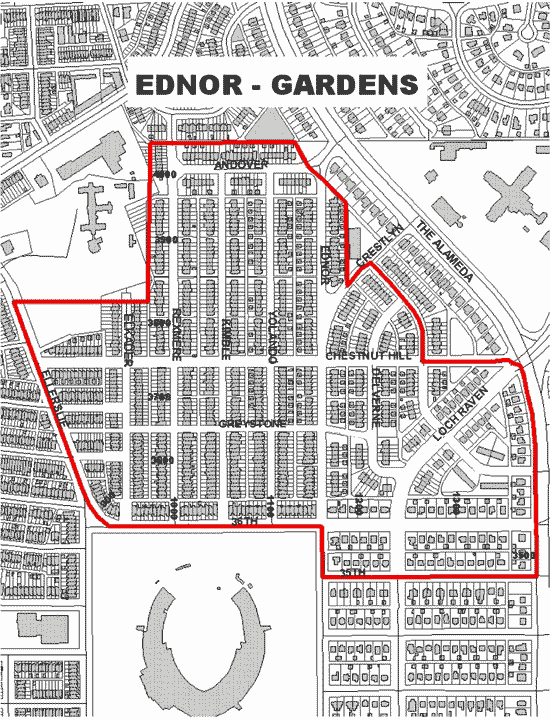Ednor Gardens
National Register of Historic Places - 03/30/2004
 The Ednor Gardens Historic District is an approximately fifty-acre, primarily rowhouse, community developed by the large scale Baltimore building developer Edward J. Gallagher and his sons between 1925 and 1950. The district comprises some twenty-nine blocks located in north Baltimore, east of Greenmount Avenue, and bounded by 36th Street on the south; the west side of the Alameda on the east; the north side of Andover Road on the north; and, on the west, a line formed by the following courses: the west side of Rexmere Road, the north side of Chestnut Hill Avenue, and the east side of Ellerslie Avenue, continuing south until it meets 36th Street.
The Ednor Gardens Historic District is an approximately fifty-acre, primarily rowhouse, community developed by the large scale Baltimore building developer Edward J. Gallagher and his sons between 1925 and 1950. The district comprises some twenty-nine blocks located in north Baltimore, east of Greenmount Avenue, and bounded by 36th Street on the south; the west side of the Alameda on the east; the north side of Andover Road on the north; and, on the west, a line formed by the following courses: the west side of Rexmere Road, the north side of Chestnut Hill Avenue, and the east side of Ellerslie Avenue, continuing south until it meets 36th Street.
Ednor Gardens is distinguished by its Tudor, Norman, and, later, Colonial style rowhouses that reflect national changes in residential architectural tastes between the mid 1920s into the late 1930s. Using his son as architect, Edward J. Gallagher set about to create a new kind of rowhouse community in Baltimore, "the English village in the city" with stylish houses aimed at a middle income market and offering all the modern construction made Ednor Gardens the most aesthetically successful of the several English style rowhouse of integrity and the terraced gardens planned by the developer as part of his overall concept have reached maturity. When the company began building again in 1936, after the worst years of the Depression, Gallagher, Jr. was designing "colonial" detached and rowhomes, reflecting a national design choice influenced by the opening of Colonial Williamsburg in the early 1930s.
Significance
Ednor Gardens gains its significance from the fact that it is a community that closely represents the stylistic changes in architectural taste that look place in many parts of America in the later 1920s into the post World War II era. The early years of the community reflect the architectural styles chosen for the new American suburbs of the 1890s, however, the effects of the Depression, as well as the opening of Colonial Williamsburg, had influenced Americans to see the security of their colonial past and "colonial" or "early American" styles became the rage, a national trend clearly reflected in the later development of Ednor Gardens.
The community is also significant for the fact that it is among the last work of a prototypical American building developer. Who began his career on a small scale in the 1890s, but the early 1900s was among the four largest scaled builders in Baltimore who were beginning to acquire large parcels of land on which to build moderately priced houses for the rapidly expanding working class. By the era of War World II this developer had begun to build larger homes for the middle classes, a shift in operations that culminated in the development of the stylish English village of Ednor Gardens.